LIFE SCIENCES GRADE 12 QUESTIONS - NSC EXAMS PAST PAPERS AND MEMOS JUNE 2019
Share via Whatsapp Join our WhatsApp Group Join our Telegram GroupLIFE SCIENCES
GRADE 12
NSC EXAMS
PAST PAPERS AND MEMOS JUNE 2019
INSTRUCTIONS AND INFORMATION
Read the following instructions carefully before answering the questions.
- Answer ALL the questions.
- Write ALL the answers in your ANSWER BOOK.
- Start the answers to EACH question at the top of a NEW page.
- Number the answers correctly according to the numbering system used in this question paper.
- Present your answers according to the instructions of each question.
- ALL drawings must be done in pencil and labelled in blue or black ink.
- Draw diagrams, flow charts or tables only when asked to do so.
- The diagrams in this question paper are NOT necessarily drawn to scale.
- Do NOT use graph paper.
- You must use a non-programmable calculator, protractor and a compass where necessary.
- Write neatly and legibly.
QUESTIONS
SECTION A
QUESTION 1
1.1 Various options are given as possible answers to the following questions. Choose the correct answer and write only the letter (A–D) next to the question number (1.1.1–1.1.9) in the ANSWER BOOK, for example 1.1.0 D.
1.1.1 The term used to describe the observable features of an organism:
- Alleles
- Genes
- Genotype
- Phenotype
1.1.2 A cell divides to produce gametes. This process will …
- supply cells for the replacement of damaged tissue.
- produce cells that are genetically identical.
- involve one nuclear division.
- produce haploid cells.
1.1.3 Trisomy 21 is a genetic disorder in which an individual has an extra copy of chromosome 21. Which process could cause Trisomy 21?
- Failure of a chromosome to replicate during mitosis
- Failure of chromosome pairs to join during fertilisation
- Failure of chromosome pairs to separate properly during meiosis
- Failure of a chromosome to cross over during replication
1.1.4 A piece of DNA has 1 500 bases. 400 of these bases are guanine. How many adenine bases would there be in this piece of DNA?
- 400
- 350
- 700
- 750
1.1.5 The diagram below represents a simple reflex arc. What is the correct sequence of nerve cells through which an impulse passes during a reflex action? 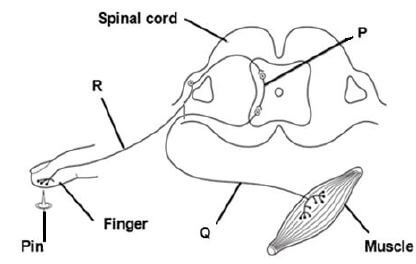
- P → Q → R
- Q → R → P
- Q → P → R
- R → P → Q
1.1.6 The following information shows the alleles belonging to a married couple.
XH – Dominant allele for normal blood
Xh – Recessive allele for haemophilia
Which of the following crosses will produce male offspring who are all haemophiliacs?
- XHY x XhXh
- XHY x XHXh
- XhY x XHXh
- XhY x XHXH
1.1.7 A study was carried out on a lion (male), a lioness (female) and a group of cubs. Samples of DNA were extracted from the animals and analysed. The results are shown in the diagram below, in which the dark bands represent fragments of DNA of a specific length. 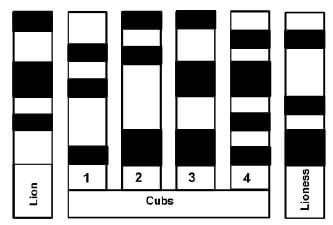
Which of the cubs could be the offspring of the lion and lioness studied?
- 1, 2 and 3
- 1, 2 and 4
- 2, 3 and 4
- 1, 3 and 4
1.1.8 Which sequence correctly shows the path of sound transmission in the ear?
- Tympanic membrane →Eustachian tube → semicircular canals → cochlea
- Tympanic membrane → semicircular canals → Eustachian tube → cochlea
- Auditory canal → ossicles → tympanic membrane → organic of Corti
- Auditory canal → tympanic membrane → ossicles → organ of Corti
1.1.9 A diploid sheep’s nucleus X is inserted into an ovum without nucleus of sheep Y to form a zygote. The zygote is then implanted into the uterus of a surrogate mother sheep. What is the genetic composition of the lamb produced?
- Sheep X
- Sheep Y
- Sheep Z
- Sheep X and Sheep Y (9 x 2) (18)
1.2 Give the correct biological term for each of the following descriptions. Write only the term next to the question number (1.2.1–1.2.7) in the ANSWER BOOK.
1.2.1 The organelle which is the site of protein synthesis
1.2.2 The basic unit of inheritance of a particular characteristic
1.2.3 A change in the genetic composition of an organism
1.2.4 Having different alleles for a characteristic
1.2.5 A rapid, automatic response to an external stimulus
1.2.6 Protective membrane situated over the cornea of the eye
1.2.7 A disease that is characterised by a loss of the myelin sheath of neurons in the brain (7 x 1) (7)
1.3 Indicate whether each of the statements in COLUMN І applies to A ONLY, B ONLY, BOTH A and B or NONE of the items in COLUMN ІІ. Write A only, B only, both A and B or NONE next to the question number (1.3.1–1.3.3) in the ANSWER BOOK. (3 x 2) (6)
COLUMN І | COLUMN ІІ |
1.3.1 Location of DNA in a human | A: Chloroplasts |
1.3.2 The scientist(s) who discovered the structure of DNA | A: Darwin |
1.3.3 The division of the nervous system that controls reactionof the body to an emergency | A: Sympathetic |
1.4 The diagram below shows part of the process of DNA replication.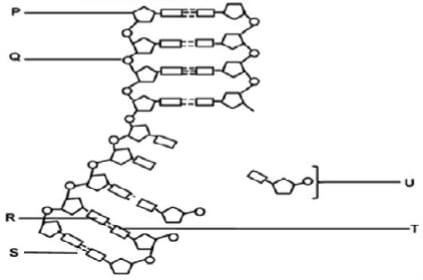
1.4.1 Identify the:
- Structure labelled P (1)
- Structure labelled Q (1)
- Bond labelled S (1)
- Molecule labelled U (1)
1.4.2 Name the base labelled T on the new DNA molecule if the base labelled R on the parent DNA molecule is guanine. (1)
1.5 In tomato plants, the genes for stem colour and presence of epidermal hairs are found on different chromosomes. The allele for purple stem P is dominant to the allele for green stem p and the allele for hairy stem H is dominant to the allele for smooth stem h. The Punnett square below shows a part of the cross between two plants. Genotype (i) has been left out. 
1.5.1 Give the:
- Genotype of plant 1 (2)
- Phenotype of plant 2 (2)
- Genotype of offspring (i) (1)
1.5.2 What percentage of offspring is having green and smooth stems? (1)
1.5.3 State the genotypes of TWO gametes from the table that will result in offspring that are heterozygous for both traits, if fertilisation occurs. (2)
1.6 The brain acts as the main coordinated centre for nervous activity. It receives information, interprets it and responds accordingly. 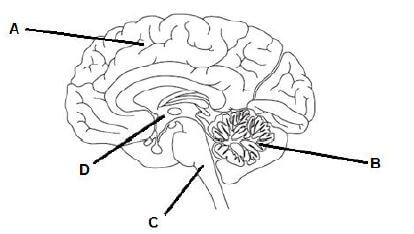
1.6.1 Give the LETTER only of the part of the brain that controls the following:
- Breathing (1)
- Memory (1)
1.6.2 The part labelled A is made up of two similar halves. How are these two halves attached to each other? (1)
1.6.3 State ONE way in which the brain is protected. (1)
1.6.4 State TWO reasons why humans need a nervous system. (2)
TOTAL SECTION A: 50
SECTION B
QUESTION 2
2.1 The diagram below shows some of the changes that occur during the menstrual cycle. 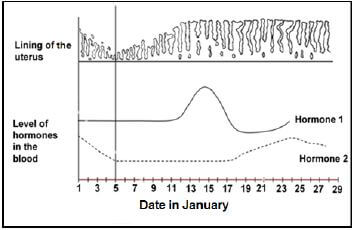
2.1.1 Between which dates did menstruation take place? (1)
2.1.2 On which date did ovulation take place? (1)
2.1.3 Identify hormones 1 and 2, respectively. (2)
2.1.4 Describe the relationship between the level of hormone 1 and ovulation. (2)
2.1.5 Explain what will happen to the lining of the uterus after 28 January. (2)
2.2 Read the passage below.
Seahorses are strange but interesting animals in which the male seahorses undergo pregnancy and give birth to young seahorses. The male seahorse has a pouch (bag) on its stomach in which to carry babies. |
2.2.1 Identify the type of reproduction seahorses have. (1)
2.2.2
- What type of fertilisation does the seahorse have? (1)
- Explain your answer to QUESTION 2.2.2(a). (1)
2.2.3 Why is the seahorse reproductive strategy considered to be ovovivipary? (2)
2.3 The hormone insulin is a relatively small protein made up of 110 amino acids. Researchers studying the production of insulin in the cells of the pancreas noted that one of the early steps in this process was the formation of a polypeptide called preproinsulin. Researchers noted that the formation of this polypeptide required repeated use of different types of molecule X, as shown below. 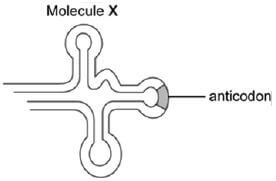
2.3.1 Name molecule X. (1)
2.3.2 Briefly describe how molecule X plays a role in the production of the polypeptide, preproinsulin. (5)
2.3.3 The table below shows mRNA codons and the amino acids they code for.
mRNA CODON | AMINO ACID |
AAC | Asparagine (Asn) |
UGU | Cysteine (Cys) |
CAG | Glutamine (Gln) |
CAU | Histidine (His) |
UUA | Leucine (Leu) |
UUU | Phenylalanine (Phe) |
UCU | Serine (Ser) |
GUC | Valine (Val) |
The sequence of amino acids 1 to 8 in the preproinsulin polypeptide is shown below.
phe-val-asn-gln-his-leu-cys-ser
Use the table shown above to determine the:
- mRNA codon coding for the 4th amino acid from left to right (1)
- Anticodon on molecule X if the amino acid carried is asparagine (1)
2.3.4 A mutation occurred during the formation of preproinsulin resulting in the formation of the following molecule:
phe-val-asn-gln-his-phe-cys-ser
Use the table above to describe how this mutation occurred. (3)
2.4 Huntington’s disease damages the nervous system. It is an inherited condition caused by a dominant allele (H). Only individuals who are homozygous for the recessive allele (h) are protected from the disease. The diagram shows the inheritance of Huntington’s disease in a family. 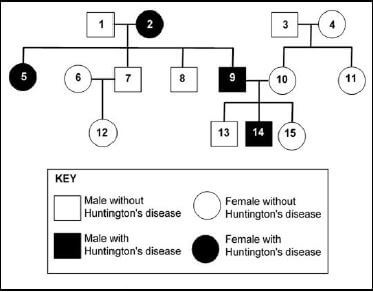
2.4.1 How many individuals in this family each fit the description given below?
- Females with Huntington’s disease (1)
- Homozygous recessive (1)
2.4.2 Determine the:
- Phenotype of individual 3 (1)
- Genotype of individual 2 (1)
2.4.3 Individual 1 and 2 both have male and female children. Use a genetic cross to show how they can produce both male and female children. (6)
2.5 The diagram below represents the phases during meiosis. 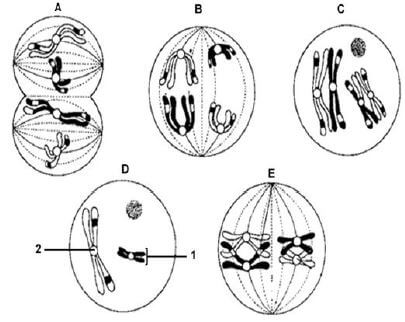
2.5.1
- State whether the diagrams represent meiosis I or meiosis II. (1)
- Give ONE reason for your answer in QUESTION 2.5.1 (a). (1)
2.5.2 Identify structures labelled 1 and 2. (2)
2.5.3 Arrange the phases in the correct sequence using LETTERS (A–E) only. (2) [40]
QUESTION 3
3.1 Human blood groups are controlled by multiple alleles.
3.1.1 Name ALL the alleles that controls human blood groups. (3)
3.1.2 How many of the alleles named in QUESTION 3.1.1 can any individual inherit? (1)
3.1.3 Give a reason for your answer in QUESTION 3.1.2. (2)
3.1.4 A man has blood group A and his wife has blood group B. Their first child has blood group AB and the second child has blood group O. What can one conclude about the blood groups of their future children? (3)
3.2 The iris of the eye has the ability to regulate the amount of light entering the eye in order to prevent damage to the eye. It does so by regulating the size of the pupil when it is exposed to varying light intensities. Scientists did an investigation to determine the effect of dim light on the diameter of the pupil. The procedure was as follows:
- A person in a darkened room was asked to cover one eye.
- A dim electric bulb positioned at varying distances from the person was switched on at one-minute intervals for a period of 10 seconds. (Not all measurements were at different distances from the person’s eye.)
- During this period the diameter of the pupil was measured.
The results obtained are shown in the table below.
| Time intervals (in minutes) | 1 | 2 | 3 | 4 | 5 | 6 | 7 | 8 | 9 |
| Diameter of pupil (in mm) | 2 | 4 | 5 | 5 | 8 | 7 | 3 | 1 | 6 |
3.2.1 Name the mechanism by which the iris regulates the amount of light entering the eye. (1)
3.2.2 Identify the:
- Independent variable (1)
- Dependent variable (1)
3.2.3 Plot a line graph to show the above results. (6)
3.2.4 Between which two measurements did the largest decrease in the diameter of the pupil occur? (1)
3.2.5 Explain why the diameter of the pupil remained the same during the third- and fourth-time interval. (2)
3.2.6 List ONE way how the scientists ensured the validity of this investigation. (1)
3.2.7 Explain why the results of this investigation cannot be considered to be reliable. (2)
3.3 Genetic engineering uses biotechnology to satisfy human needs. One form of this is in stem cell research.
- Define stem cells. (2)
- State THREE sources of stem cells. (3)
- Explain the significance of stem cells. (3)
3.4 The diagram below represents structures in the inner ear. 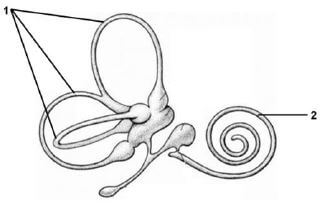
3.4.1 Identify structures labelled 1 and 2. (2)
3.4.2 Explain the significance of the structure labelled 2 being coiled. (2)
3.4.3 Describe the role of the structure above in maintaining balance. (4) [40]
TOTAL SECTION B: 80
SECTION C
QUESTION 4
Describe the process responsible for the formation of gametes in human males and females as well as the development of the embryo from fertilisation until implantation.
Content: (17)
Synthesis: (3)
NOTE: NO marks will be awarded for answers in the form of tables, flow charts or diagrams.
TOTAL SECTION C: 20
GRAND TOTAL: 150